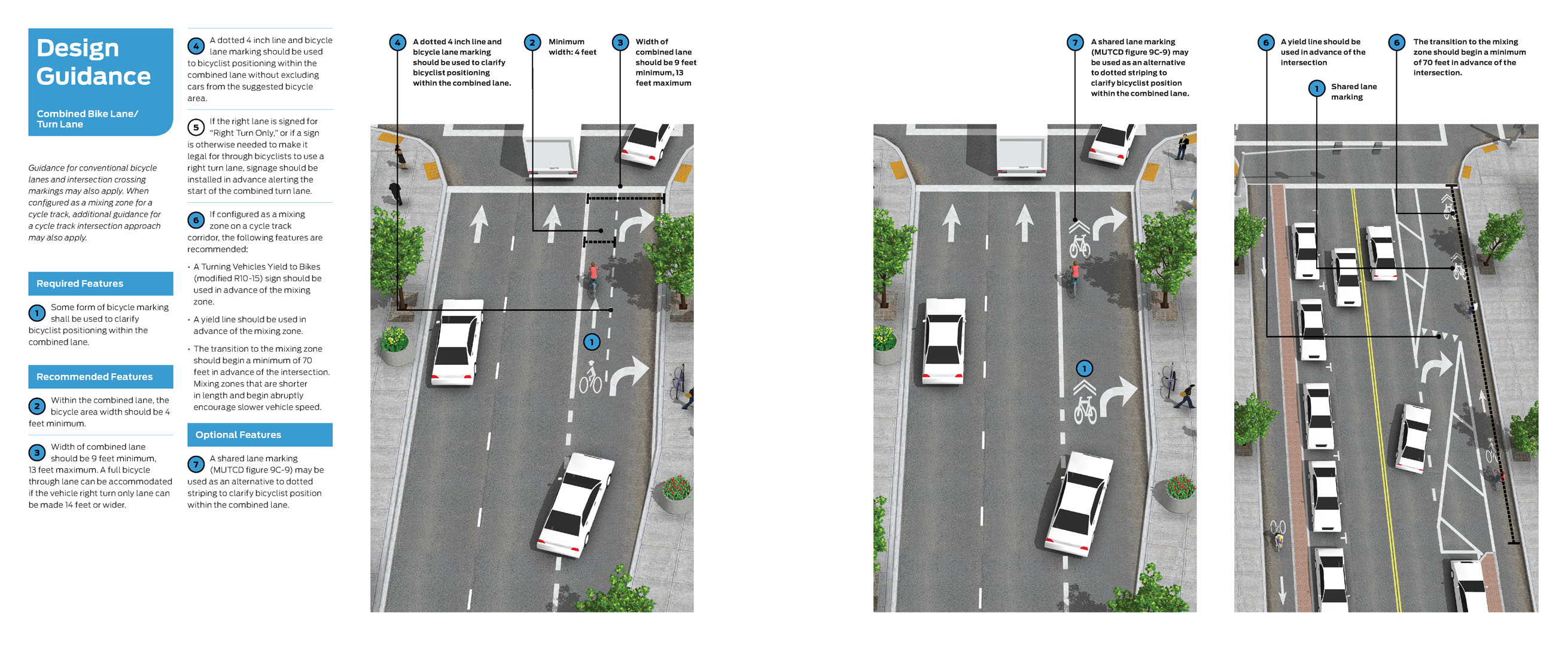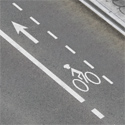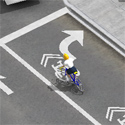Since the publication of the NACTO Urban Bikeway Design Guide, NACTO has released additional intersection design guidance.
See this new resource >
Description
A combined bike lane/turn lane places a suggested bike lane within the inside portion of a dedicated motor vehicle turn lane. Shared lane markings or conventional bicycle stencils with a dashed line can delineate the space for bicyclists and motorists within the shared lane or indicate the intended path for through bicyclists. This treatment includes signage advising motorists and bicyclists of proper positioning within the lane.
When configured on a cycle track corridor, the combined lane is commonly called a mixing zone, and is intended to minimize conflicts with turning vehicles at intersections as an alternative to an exclusive bike signal phase.
Click on the images below to view 3D concepts of combined right-turn bike lanes. The configuration shown is based on Eugene, OR and New York City, NY examples.
Treatment details can be accessed below under design guidance.
Benefits
- Preserves positive guidance for bicyclists in a situation where the bicycle lane would otherwise be dropped prior to an intersection.
- Maintains bicyclist comfort and priority in the absence of a dedicated bicycle through lane. Read More+
“More than 17 percent of the surveyed bicyclists using the narrow-lane intersection felt that it was safer than the comparison location with a standard-width right-turn lane, and another 55 percent felt that the narrow-lane site was no different safety-wise than the standard-width location.”
Hunter, W.W. (2000). Evaluation of a Combined Bicycle Lane/Right-Turn Lane in Eugene, Oregon. Publication No. FHWA-RD-00-151, Federal Highway Administration, Washington, DC.
- Guides bicyclists to ride in part of the turning lane, which tends to have lower speed traffic than the adjacent through lane, allowing higher speed through traffic to pass unimpeded.
- Encourages motorists to yield to bicyclists when crossing into the narrow right-turn lane.
- Reduces motor vehicle speed within the right turn lane.
- Reduces the risk of ‘right hook’ collisions at intersections.
Typical Applications
- On streets where there is a right turn lane but not enough space to maintain a standard-width bicycle lane at the intersection.
- On streets where there is no dedicated right turn lane, but on which high volumes of right turning traffic may cause conflicts between motorists and bicyclists.
- On cycle track corridors where there is a dedicated turn lane on the side of the street with the cycle track, but where a separate bike signal phase is not appropriate or feasible.
- May not be appropriate at intersections with very high peak automobile right turn demand.
Design Guidance

Guidance for conventional bicycle lanes and intersection crossing markings may also apply.
| Required Features |
 |
Some form of bicycle marking shall be used to clarify bicyclist positioning within the combined lane. |
| Optional Features |
 |
A shared lane marking (MUTCD figure 9C-9) may be used as an alternative to dotted striping to clarify bicyclist position within the combined lane. |
Maintenance
- Markings within the shared lane will require regular maintenance and marking repairs due to frequent wear from motor vehicle use. Inlaid thermoplastic application is recommended for increased durability.
Treatment Adoption and Professional Consensus
Currently used in the following US Cities:
- Austin, TX
- Bend, OR
- Billings, MT
- Colorado Springs, CO
- Chicago, IL
- Eugene, OR
- Kona, HI
- New York, NY
- Portland, OR
- Provo, UT
- San Francisco, CA
- Washington, DC